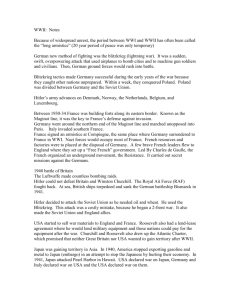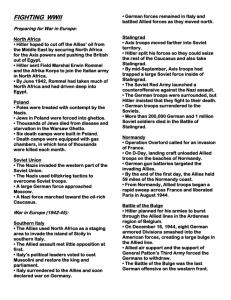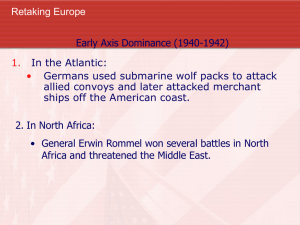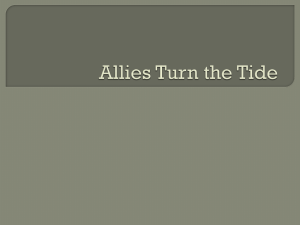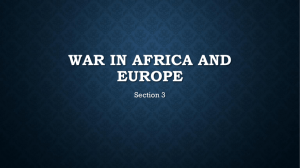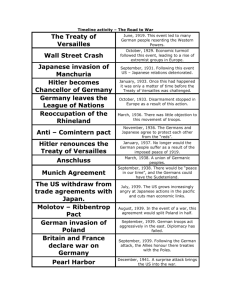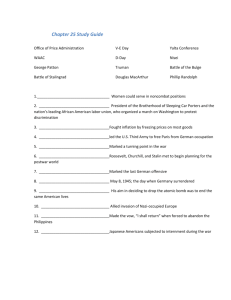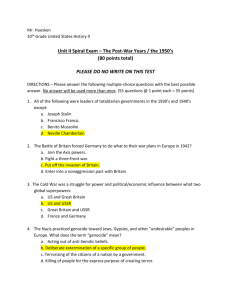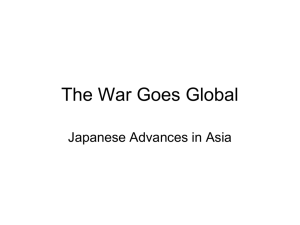Origins of World War II
advertisement
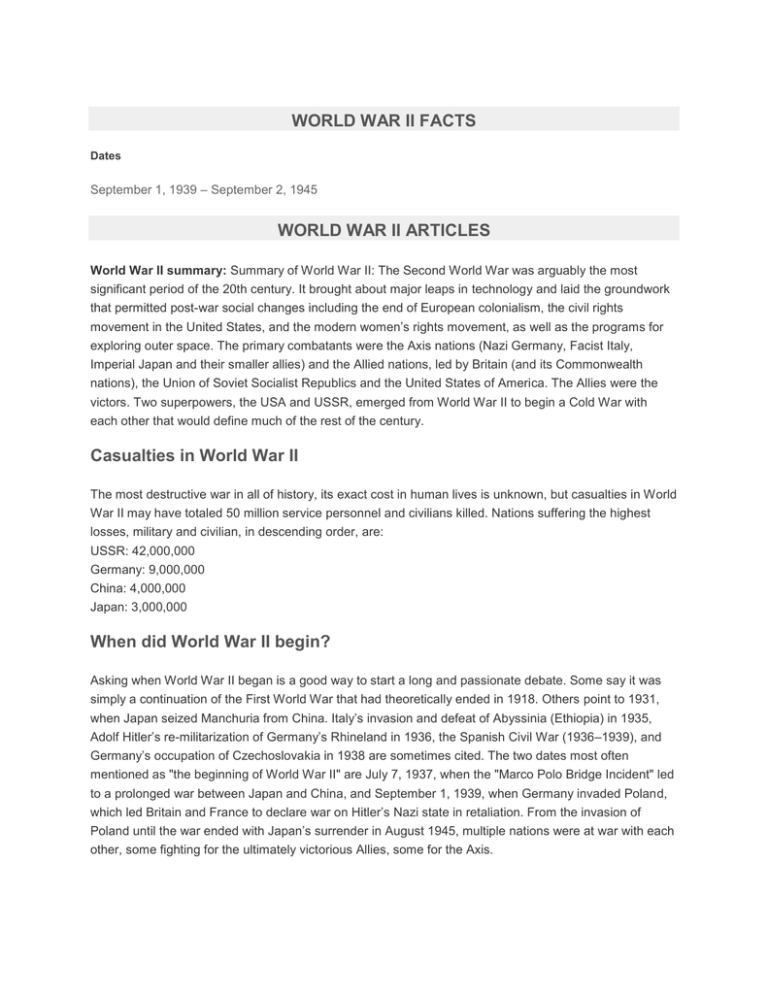
WORLD WAR II FACTS Dates September 1, 1939 – September 2, 1945 WORLD WAR II ARTICLES World War II summary: Summary of World War II: The Second World War was arguably the most significant period of the 20th century. It brought about major leaps in technology and laid the groundwork that permitted post-war social changes including the end of European colonialism, the civil rights movement in the United States, and the modern women’s rights movement, as well as the programs for exploring outer space. The primary combatants were the Axis nations (Nazi Germany, Facist Italy, Imperial Japan and their smaller allies) and the Allied nations, led by Britain (and its Commonwealth nations), the Union of Soviet Socialist Republics and the United States of America. The Allies were the victors. Two superpowers, the USA and USSR, emerged from World War II to begin a Cold War with each other that would define much of the rest of the century. Casualties in World War II The most destructive war in all of history, its exact cost in human lives is unknown, but casualties in World War II may have totaled 50 million service personnel and civilians killed. Nations suffering the highest losses, military and civilian, in descending order, are: USSR: 42,000,000 Germany: 9,000,000 China: 4,000,000 Japan: 3,000,000 When did World War II begin? Asking when World War II began is a good way to start a long and passionate debate. Some say it was simply a continuation of the First World War that had theoretically ended in 1918. Others point to 1931, when Japan seized Manchuria from China. Italy’s invasion and defeat of Abyssinia (Ethiopia) in 1935, Adolf Hitler’s re-militarization of Germany’s Rhineland in 1936, the Spanish Civil War (1936–1939), and Germany’s occupation of Czechoslovakia in 1938 are sometimes cited. The two dates most often mentioned as "the beginning of World War II" are July 7, 1937, when the "Marco Polo Bridge Incident" led to a prolonged war between Japan and China, and September 1, 1939, when Germany invaded Poland, which led Britain and France to declare war on Hitler’s Nazi state in retaliation. From the invasion of Poland until the war ended with Japan’s surrender in August 1945, multiple nations were at war with each other, some fighting for the ultimately victorious Allies, some for the Axis. Origins of World War II No one historic event can be said to have been the origin of World War II. Japan’s unexpected victory over czarist Russia in the Russo-Japanese War (1904-05) left open the door for Japanese expansion in Asia and the Pacific. The United States U.S. Navy first developed plans in preparation for a naval war with Japan in 1890. War Plan Orange, as it was called, would be updated continually as technology advanced and greatly aided the U.S. during World War II. The years between the first and second world wars were a time of instability during the worldwide Great Depression that began around 1930. It was also a time when some nations, including Germany, Italy and Japan developed intense nationalist feelings that led to a desire to expand: Germany in Northern and Eastern Europe, Italy in Africa and Greece, and Japan in Asia and the South Pacific. Germany had the added motivation of overturning (and ultimately avenging) the harsh terms forced on it at the conclusion of the First World War. Competing ideologies further fanned the flames of international tension. The Bolshevik Revolution in czarist Russia during the First World War, followed by the Russian Civil War, had established the Union of Soviet Socialist Republics (USSR), a sprawling communist state. Western republics and capitalists feared the spread of Bolshevism. In some nations, such as Italy, Germany and Romania, ultra-conservative groups rose to power, in part as a reaction against communism. Germany, Italy and Japan signed agreements of mutual support but, unlike the Allied nations they would face, they never developed a comprehensive or coordinated plan of action. Initial Moves of the Second World War On July 7, 1937, a skirmish near the Marco Polo Bridge near Beijing, China, led to open warfare between Japan and China. The outclassed Chinese military traded space for time, steadily withdrawing deeper into the large country to extend Japanese supply lines and hoping to eventually gain assistance from other nations. During the course of the war over 1 million Japanese troops would be engaged in an unsuccessful attempt to subdue China. The fighting in Europe began on September 1, 1939, when Germany invaded Poland. Previously, Germany, led by Nazi Party leader Adolf Hitler, had annexed Czechoslovakia and Austria without provoking a military response from France or Great Britain. Poland was a step too far; both of those nations declared war on Germany in support of Poland, but they were slow to take effective actions. The French military and government expected Poland would hold out till spring, allowing France time to mobilize. But Germany demonstrated the effectiveness of combined arms warfare, in which infantry, armor, artillery and aircraft work in coordination. This type of war required rapid communication; in preparation, the Germans had developed radios small enough that every vehicle could be equipped with one. This new style of warfare became known as blitzkrieg (lightning war—the Germans actually used the term blitzkrieg to refer to a war of short duration, but it came to refer to combined-arms tactics of rapid maneuver). Germany quickly drove deep into Poland. Two weeks after the war began, the USSR invaded from the east; Joseph Stalin, leader of the USSR, had earlier signed a mutual non-aggression pact with Hitler, and secretly they had agreed to divide Poland between them. Before the end of the month, Poland had capitulated. In the coming months, Denmark, Norway, and the Baltic States also fell under Nazi control. In May 1940, Germany shocked the world by rapidly invading and defeating the Netherlands, Belgium, Luxembourg, France and a British Expeditionary Force that was aiding the French. Operations began May 10 with attacks on Holland and ended June 25, when France signed an armistice that divided the country into occupied and unoccupied zones. The Germans controlled the occupied zones, in the north and northwest, which comprised three-fifths of the country; a new French government established at Vichy administered the southern two-fifths. Italy’s leader, Benito Mussolini, hoped to get in on the spoils and declared war on France June 10; Italian forces attacked southern France on June 21. On July 10, an air war over England began, which British prime minister Winston Churchill termed the Battle of Britain. The German Luftwaffe was to knock out the Royal Air Force (RAF) in preparation for Operation Sealion, the proposed naval invasion of Britain, or force Churchill to seek a negotiated peace. Though it was a near-run thing, the defense mounted by the badly outmanned RAF led Hitler to abandon plans for the invasion; the Battle of Britain ended September 30. Operation Barbarossa Finally, on June 22, 1941, Germany and its allies launched Operation Barbarossa, a massive invasion of the Soviet Union from the Baltic shore in the north to the Black Sea in the South. The Soviets were caught by surprise. (The USSR knew Germany would attack eventually and had wargamed various scenarios but did not expect the invasion so soon.) Their military leadership had been decimated by Stalin’s purges of the 1930s, in which he removed—often killed—many of the most effective commanders and replaced them with political stooges. In the Finnish-Soviet War (Winter War) between November 30, 1939 and March 12, 1940, tiny Finland repeatedly stymied an invasion by the giant Soviet Union for months until finally forced to yield to overwhelming numbers; the peace settlement gave the Soviets 25,000 square miles of Finnish territory. Initially, the Axis invasion of the USSR was a dramatic success. The invading wave swept steadily eastward, reaching the gates of Moscow by the beginning of 1942, but Soviet determination and much greater numbers of men and equipment, combined with the vast distances and severe weather of the USSR halted the onslaught and forced a German retreat. At Stalingrad two combatants fought a vicious, building-by-building, street-by-street battle from July 17, 1942, to February 2, 1943. In November 1942, the Soviets launched a two-prong counterattack that encircled and ultimately captured the German Sixth Army at Stalingrad. The Red forces advanced westward rapidly until halted in the Third Battle of Kharkov. In the spring of 1943, a bulge developed in the Soviet lines near Kursk. That summer, the Germans struck with their own two-prong assault, intending to isolated and capture or destroy Soviet forces within that bulge. Both sides committed large numbers of men and material; Kursk has long been believed to have been the largest tank battle in history but recent research is casting doubt on the long-accepted numbers. At any rate, the German offensive failed. From that point on, Soviet forces advanced westward, entering the German capital of Berlin in April 1945. The War in North Africa Britain and Commonwealth forces (Australia, Canada, India, South Africa, New Zealand) had been opposing the Axis in North Africa since Italy’s dictator Benito Mussolini declared war on Britain and France on June 10, 1940. Initially, the Italians had 250,000 troops opposing about 100,000 from the UK, but the British Army was better equipped, better trained, better organized, and had better leadership. Once the Battle of Britain was over and the threat of an immediate German invasion of the UK removed, Britain reinforced its North Africa contingent, to protect its colonies there and particularly to protect the Suez Canal and shipping in the Mediterranean. Beginning on December 9, 1940, British forces launched a drive that advanced 500 miles in two months, capturing some 130,000 prisoners and destroying 10 Italian divisions; British casualties totaled about 2,000. In mid-February 1941, two German divisions and two additional Italian divisions were sent to Libya; a third German division arrived later. German field marshal Erwin Rommel was assigned to command the Afrika Korps. He would win fame as the "Desert Fox" for his daring armored sweeps. Both sides faced significant supply problems in their operations in the North African deserts, and although Rommel achieved some great victories he could never deliver a deathblow. He never seemed to understand that for the German High Command, North Africa was always a backwater; the primary focus was on preparing to invade the Soviet Union. Britain went through a series of commanders in North Africa before placing Lt. Gen. Bernard Montgomery in charge of Eighth Army there. After halting Rommel’s attacks near El Alamein in September 1942, Montgomery launched a counterattack with a 3:1 advantage in October. When the Afrika Korps ran short on fuel and ammunition, it retired to Tunisia. The United States Enters World War II The United States of America had technically remained on the sidelines until near the end of 1941, although it had provided aid to Britain and the Soviet Union. After the Japanese attack on Pearl Harbor, December 7, 1941, (see The Pacific War, below) Congress declared war on Japan. Nazi Germany, honoring its pact with Japan, then declared war on the U.S.; Italy, Romania and other countries within the European Axis alliance did the same. America was now at war with all the Axis belligerents and would bring the full weight of its industrial power, vast natural resources and large population onto the side of the British Commonwealth and its allied nations such as the Free French, Free Poles, etc. An American officer, Major General Dwight D. Eisenhower (soon promoted to lieutenant general) was named supreme commander, Allied Expeditionary Forces, European Theater of Operations. Although the battle-tested British were skeptical about his lack of command experience, Eisenhower proved to be skilled in the diplomacy required to coordinate the commanders and forces of the many Allied nations. American troops first saw land combat against the soldiers of Nazi Germany, Italy (and some Vichy French) after the U.S. and the United Kingdom invaded Algeria and Morocco in North Africa during Operation Torch on November 8th, 1942. They pushed east toward Tunis and came within a dozen miles of their objective before German counterattacks threw them back. In February 1943 at Kasserine Pass Rommel inflicted on the U.S. forces one of the worst defeats in America’s military history but failed to achieve his strategic goals. Allied armies squeezed the Axis from the west and from the east. The Axis commanders—Rommel had been recalled to Europe—surrendered in May. Some troops were successfully evacuated to Sicily, but North Africa had cost the Axis 650,000 casualties; Britain’s losses were little more than a third of that, and America, arriving much later, suffered less than 20,000. Two American commanders came to public attention during the North African campaign and would become two of the war’s most famous generals: Lt. Gen. George S. Patton, Jr., and his deputy, Maj. Gen. Omar Bradley The Invasion of Italy Allied preparations began for the invasion of Europe through Italy. The first target was the island of Sicily. Combat there included the first large-scale use of gliders and parachute troops by the Allies. Though not particularly well handled, these airborne operations provided important lessons that would be applied later on. British forces under Montgomery and U.S. troops under Patton raced to capture the city of Messina; Patton won the race, but his men arrived just hours after the last German troops had been evacuated to the Italian mainland. Nearly 140,000 Italian troops surrendered on Sicily. The Fascist Grand Council forced Mussolini from power on July 25, 1943, and a new Italian government signed a secret armistice with the Allies on September 3. On September 8, Allied troops came ashore in Italy, and the armistice was made public. The Germans took charge of resisting the invaders. Ultimately, the Germans had to make a fighting withdrawal, but took control of northern Italy and re-installed Mussolini as head of a puppet government in that area. He and his mistress would be killed by Italian partisans on April 28, 1945. Their bodies, and those of other fascists killed at the same time, were hung upside down in Milan, where Italian fascists had executed 15 partisans a year earlier. Utilizing Italy’s mountainous terrain, cut by only a few, narrow roads, the Germans and those Italians who continued to fight alongside them established a series of defensive positions such as the Gustav Line to slow the Allied advance and inflict heavy casualties. The German command in Italy did not surrender until May 2, 1945, just days before Allied victory in Europe. The Italian campaign tied down 22 German divisions and gave the Allies lessons in amphibious warfare and in cooperation between the forces of the different nations. What they learned would prove useful during the major effort to come in France. D-Day The USSR had battled the Axis since the summer of 1941 and had faced the bulk of German military strength. Joseph Stalin continually pressured the Western Allies to open a second front; North Africa and Italy had not done enough to draw off German forces from the Soviet Union. On June 6, 1944, the Western Allies invaded France’s Normandy coast. Months of carefully planned deceptions had convinced Hitler the invasion would come at Calais, the closest point on the French coast to England. The actual targets of Operation Overlord were further west. Even so, Erwin Rommel, the Desert Fox, had established formidable defenses that included massive concrete bunkers, four million mines, and a half-million obstacles. By the day of the invasion, called D-Day, the Allies had established complete air superiority. The invasion began in darkness with three divisions of airborne troops, delivered by parachute and by glider. Many men were lost in glider crashes; descending paratroopers were shot down by German fire. Airborne troops were scattered across many miles, often far from their objectives, but they coalesced into ad hoc groups and successfully captured and held bridges and other strategic points. In the early morning hours of June 6, five Allied divisions splashed ashore along 50 miles of coastline that had been divided into five operational beaches codenamed Sword, Juno, Gold, Omaha and Utah. British divisions were to capture two, Americans were to capture two, and a Canadian division was to secure one. It was the largest amphibious operation in history. By the end of the day, over 75,000 British and Canadian troops and more than 57,000 Americans held the beaches; within a month, those numbers swelled to over a million. Moving inland proved to be a bloody slugfest. In Normandy, farmers’ fields were separated by hedgerows comprised of banks of earth covered with trees, the roots of which had intertwined over centuries to form impenetrable barriers. Roads were narrow. German defenders covered every road and every hedgerow opening. Not until Operation Cobra, July 25–31, a sweep around the Germans’ western flank, were the Allies able to break out of the hedgerow country and begin a fast-moving drive on Paris and then to the German border. The Allied Race Across France On August 15 a second invasion, Operation Dragoon, succeeded in southern France. Everywhere within that country, German infantry and armored units were in retreat. The Allies’ greatest obstacle was logistics: keeping their mechanized and motorized divisions supplied with fuel, food, ammunition and other necessities. The Red Ball Express, made up of nearly 6,000 trucks, rushed supplies forward. During the 81 days of its existence, the Red Ball transported over 800,000 gallons of fuel a day and a total of over 412,000 tons of other war supplies. The Allies enjoyed a enormous superiority in the number and quality of trucks during the war, an advantage that was as important as the fighting men and machines they kept supplied and mobile. German resistance stiffened as the onrushing Allies approached the Rhine River and Germany itself. In September 1944, Operation Market-Garden attempted to secure bridges across the Rhine in Holland, using three airborne divisions dropped near the town of Arnhem and an overland drive by 20,000 vehicles. It was a costly failure. At almost the same time, the American 9th Infantry Division attacked into the Hurtgen Forest, beginning a costly and poorly managed campaign that dragged on until the following February. Battle of the Bulge Just south of the Hurtgen Forest, German troops were secretly massing a quarter-million men, nearly 1,000 tanks and mechanized assault guns, and 1,900 artillery pieces for a major counteroffensive that was meant to drive a wedge between the American and British sectors and re-capture the port of Antwerp in the Netherlands. Concealed by the Ardennes Forest, through which they had successfully attacked France in May 1940, they launched a surprise attack in the early hours of December 16 against a lightly defended portion of the American line. Within three days they had destroyed the American 28th and 106th divisions—but those units had delayed the advance long enough to upset the tight German timetable and allow Eisenhower time to order other units forward, including the 82nd and 101st Airborne divisions. British Field Marshal Bernard Montgomery deployed his XXX Corps on his own initiative to block the German drive to the north. The onslaught forced a bulge 50 miles wide and 70 miles deep into the American lines, giving it the name Battle of the Bulge. Staunch defenses at St. Vith and Bastogne caused the attack to grind to a halt, and by late January counterattacks had pushed the Germans back to their start line, minus 100,000 men and 700 fighting vehicles. Allied losses, primarily American, were 90,000 men and 300 fighting vehicles, but those losses could be replaced much more easily than the Germans could replace theirs. The Pacific War Isolationist sentiment was widespread in America during the 1930s, a reaction to the high casualties the U.S. took in the First World War while gaining little of significance for America. That sentiment died in the flames of American battleships burning at Pearl Harbor, Hawaii. Imperial Japan, with much of its army and air force still tied down fighting in China, had coerced the Vichy French government to grant permission for Japanese air bases in French Indochina (today’s Vietnam, Laos and Cambodia). In response, the U.S., Britain and the Netherlands imposed a total embargo on Japan. Among the most critical results of the embargo was the loss of oil. Unless Japan could import the oil it needed, its navy would be drydocked within a year and its factories would shut down in about 18 months. The Imperial military leaders saw as their only hope capturing Malaya, the Netherlands East Indies, and other counties they termed "the Southern Resource Area." This course of action meant war with the United States. Pearl Harbor On December 7, 1941, Japanese carrier-based bombers struck the American naval base at Pearl Harbor. Japan’s military planners hoped to cripple the U.S. Pacific Fleet in order to buy time to capture and fortify the region they sought to control, then negotiate an armistice from a position of strength. War had not been declared between the two nations before the attack; the Japanese embassy in Washington, D.C., took too long decoding the 5,000-word message from their homeland; however, the plan was to deliver it just 30 minutes before the bombs were to start falling anyway. America’s president, Franklin D. Roosevelt, had long wanted the U.S. involved in the war on the side of Great Britain. There have always been questions about how much Roosevelt knew of the Japanese plans and whether or not he allowed the attack to occur in order to get into the European war "through the back door." The plan to cripple the U.S. fleet failed—although a number of battleships and other vessels and facilities were severely damaged or destroyed—primarily because none of the American aircraft carriers based at Pearl were in the harbor that Sunday morning. They were on assignments at sea, including an assignment to find the Japanese fleet that was known to have sailed days earlier. In addition to bombing Pearl Harbor, Japan swept through British Malaya in a "bicycle blitzkrieg" and captured "impregnable Singapore," seizing more territory in a shorter amount of time than any nation since Napoleon’s France. It was now at war with China, the United States, the United Kingdom and Commonwealth nations (notably Australia, New Zealand, India and Burma), and the Netherlands. (In 1938, Japanese forces had been decisively beaten by those of the Soviet Union in the Battle of Khalkin Gol, and those two nations signed a non-aggression pact that would last until the final weeks of World War II.) Midway and Guadalcanal Planes from the American fleet found the Japanese ships first and destroyed four of their carriers in the Battle of Midway. Only one American carrier was lost. Midway is often called the turning point in the War in the Pacific because it destroyed the myth of Japanese invulnerability. Another, and perhaps more significant turning point, came with the battle for Guadalcanal, August 1942– February 1943. To halt construction of a Japanese airbase on the island of Guadalcanal, which would have allowed air strikes against Allied supply convoys to Australia, the U.S. Marines and Army invaded the island. Fighting was intense on land, sea and air. In the end, the Japanese had to evacuate their remaining 12,000 troops. Fighting was always brutal between the two sides, wherever they faced each other. Surrender was so shameful in Japan’s Bushido culture that, as one American officer expressed it after the war, "Every nation said its soldiers would fight to the last man. Only the Japanese did it." The names of islands like New Guinea, Tarawa, Peleliu, the Marianas, the Philippines, Iwo Jima, Okinawa and others would be written in the blood of Japanese, American, Australian and New Zealand servicemen. Allied strategy was to capture a series of islands, constantly moving closer to Japan, and use those islands as supply bases from which to launch the next assault. This required a combined land-sea approach. Unlike the European Theater, there was no single supreme commander, as Eisenhower was in Europe. Douglas MacArthur, a former Army Chief of Staff, was named supreme commander of Allied forces in the Southwest Pacific after his evacuation from the Philippines in 1942. Fleet Admiral Chester Nimitz became supreme commander of Allied forces in the Pacific Ocean Area that same year. Lieutenant General Joseph Stilwell commanded all U.S. forces in the China-Burma-India Theater; Britain’s Archibald Wavell was commander in chief in India, after being replaced as commander in North Africa. American general Curtis LeMay oversaw the strategic aerial bombing campaign against Japan. Iwo Jima and Okinawa As the Allies neared the Japanese home islands, they fought fierce battles to capture small islands nearby, to use as air and supply bases. At Iwo Jima, which is just eight square miles in size, operations began February 19, 1945, and lasted until March 26, though pockets of resistance remained in cave complexes through May. Only 300 of the 21,000 Japanese defenders were taken alive. American losses were approximately 6,500 dead and 20,000 thousand wounded. March–June 1945 saw the last major battle for a Pacific island. Okinawa is just 60 miles long and just 18 miles across at its widest point. An assault force of 180,000 was sent to wrest it from 130,000 defenders. Over 107,000 Japanese military and civilian personnel died, including women who threw their babies into the sea from cliffs, then jumped themselves because Japanese propaganda had convinced them the Americans would torture them. The Americans lost some 13,000 dead and 49,000 wounded among their land forces. Additionally, kamikaze attacks sunk 36 American and British ships and damaged 368 more. One of the damaged, the USS Indianapolis, would be sent to California for repairs; it returned from there carrying the atom bomb to Tinian Island but was sunk shortly after delivering its lethal package. Atom Bombs After capturing the island of Okinawa in an 82-day battle, Allied planners began preparing for the invasion of the Japanese home islands. Based on their experience with the tenacious, fatalistic defense Japanese troops had displayed through the Pacific, they were aware these operations would cost large numbers of American and British Commonwealth lives. Some estimates in popular media ran as high as a million; military planners expected a few hundred thousand. They also feared that a homefront weary of war would demand a negotiated settlement if the war dragged on into 1946. Allied salvation came in August 1945. An American B-29 dropped a single atomic bomb on the city of Hiroshima, obliterating the town. When no Japanese surrender was forthcoming, a second bomb fell on Nagasaki. While the world was shocked by the high number of primarily civilian casualties and massive destruction wrought by a single explosive device, in fact far more Japanese had been killed in the firebombings that U.S. planes had been carrying out for months. End of World War II On August 15, 1945, Japan formally surrendered. World War II was over. A new age of nuclear weapons had begun, and a cold war between the two superpowers that emerged from the war—the United States and the Soviet Union—would result in many "surrogate wars" in the decades to come, wars fought in and between nations backed by one side or the other. The Holocaust and Other Atrocities of World War II Nazi Germany’s fascination with producing a "racial pure" culture led to a campaign to eliminate "Untermensch" ("sub-humans"). The largest of these groups were European Jews but also included Gypsies, some Slavs, the mental ill, homosexuals, communists, socialists, and any other group termed undesirable. Millions—six million Jews alone—were executed; some were tortured, shot or hanged; others gassed or starved to death in concentration camps (death camps), were worked to death as slave labor, or killed by other means. This systemic murder is known as The Holocaust, a Greek word meaning "sacrifice by fire." Any nation that fell under German dominance, whether by conquest or political agreement, was expected to join in the purging of the Untermensch. Imperial Japan also believed its people were racially superior, and therefore any act conducted against other Asians or Westerners was justified. At Nanking tens of thousands of Chinese were buried alive or slaughtered by other means. Chinese, Korean, Dutch and other women were forced into sexual slavery as "comfort women," each servicing dozens of Japanese military personnel daily. The Imperial Japanese Army also established Unit 731, a secret biological warfare unit that infected prisoners of war with biological agents in order to study their effectiveness. Some prisoners were cut open while they were still alive, without anesthesia, to examine the effects of the disease within their bodies. Other horrific experiments were also carried out. Unlike concentration camp guards and executioners from Europe, many of whom were tried and imprisoned or executed for their crimes, the staff of Unit 731 was granted immunity by U.S. authorities in exchange for information on their findings, for America’s own biological warfare program. The Soviet Union prosecuted a dozen members of the unit and sentenced them to labor camps. Allied governments and militaries did not set up systemic avenues of torture, rape or murder, but thousands of rapes were carried out against the women of Germany, Japan, Okinawa and even the women of Allied nations by individual soldiers. This was particularly widespread among Soviet troops in retaliation for what German soldiers had done to women of Russia, the Ukraine and other areas of the USSR. The American Joint Chiefs received reports of large numbers of rape among French, Italian and other women by U.S. forces. In Japan American admiral Raymond Spruance set up supervised brothels to reduce the rates of venereal disease and rape, but this was short-lived once a Congressman heard about it. Some Axis soldiers were shot after being captured, sometimes in anger or retaliation, sometimes during rapid advances or during combat.
